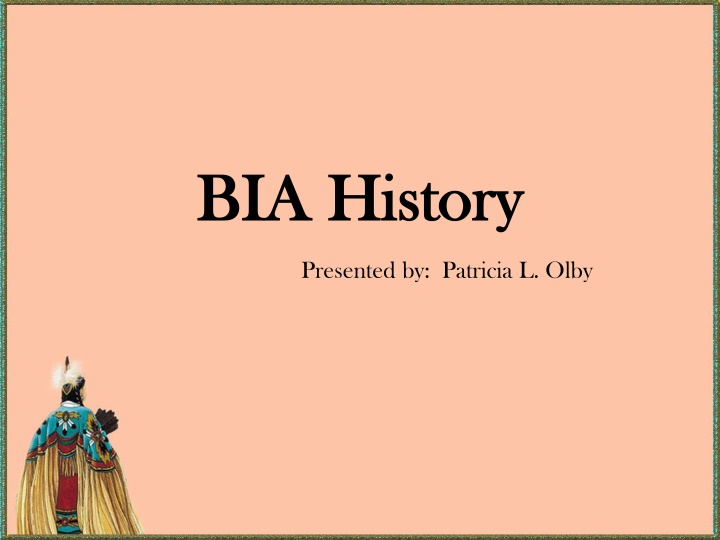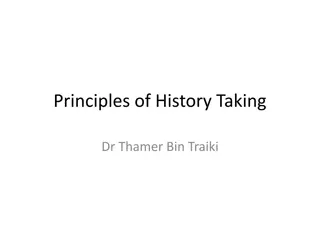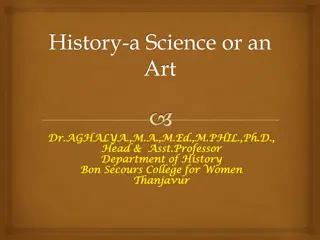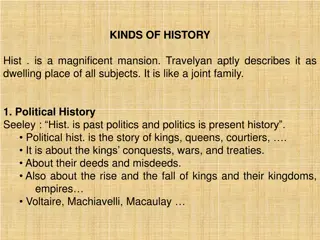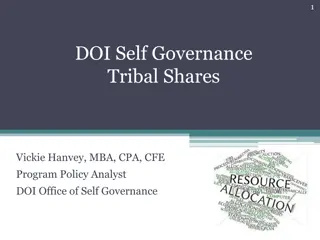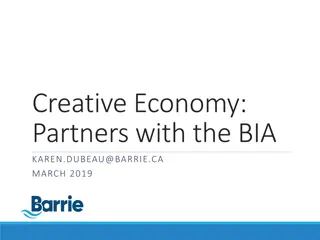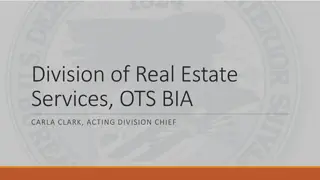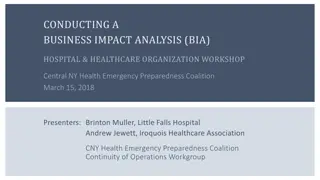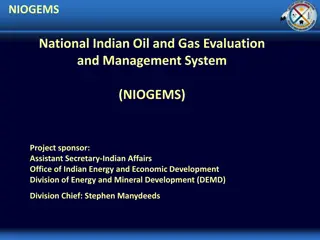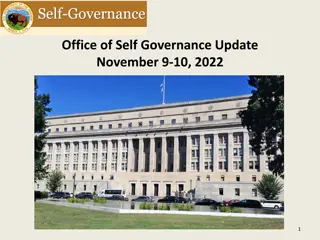BIA History
Uncover the intriguing history of the BIA as told by Patricia L. Olby. Delve into the origins, evolution, and significant milestones, providing a comprehensive understanding of this organization's past. Gain insights into the key figures, challenges faced, and contributions made over the years. Explore the valuable lessons learned from the BIA's journey, offering a unique perspective on its impact in various domains.
Download Presentation

Please find below an Image/Link to download the presentation.
The content on the website is provided AS IS for your information and personal use only. It may not be sold, licensed, or shared on other websites without obtaining consent from the author.If you encounter any issues during the download, it is possible that the publisher has removed the file from their server.
You are allowed to download the files provided on this website for personal or commercial use, subject to the condition that they are used lawfully. All files are the property of their respective owners.
The content on the website is provided AS IS for your information and personal use only. It may not be sold, licensed, or shared on other websites without obtaining consent from the author.
E N D
Presentation Transcript
BIA History BIA History Presented by: Patricia L. Olby
Background Background 1755 - The British Crown establishes an Indian Department. 1774 A committee is established for Indian Affairs 1775 through 1783 Revolutionary War 1786 The Secretary of War assumes supervision of the Indian Affairs. 1789 The United States creates the War Department because many Native American nations are still allied with the British and Spanish, Indian Affairs is moved to the newly developed War Department.
Background Background 1803 Louisiana Purchase (7 present day states, plus portions of 8 present day states for 15 Million from the French.) March 11, 1824 The Office of the Indian Affairs is formed by War Secretary John C. Calhoun in the Department of War. In 1849 Indian Affairs was transferred to the U.S. Department of the Interior. (The bureau was renamed as Bureau of Indian Affairs in 1947) 1853-1856 The United States makes over 52 treaties with various Indian nations and it gains 174 million acres of land. March 3, 1871 Congress creates an act that disallows further treaty negotiations with tribes. Past treaties are still honored, but new agreements will be in the form of executive orders or congressional acts.
The Marshall The Marshall Trilogy 1823 1823- -1832 Trilogy 1832 The Marshall Trilogy is a set of three Supreme Court decisions in the early nineteenth century affirming the legal and political standing of Indian nations. Johnson v. M Intosh (1823) Cherokee Nation v. Georgia (1831) Worcester v. Georgia (1832)
Significant Historical Events Significant Historical Events Dawes Act or General Allotment Act of 1887 Burke Act 1906 Meriam Report of 1928 Indian Reorganization Act 1934
The Dawes Act or The Dawes Act or General Allotment Act of 1887 General Allotment Act of 1887 Henry Lauren Dawes
Purposes of the Act Purposes of the Act In the Report of the Secretary of the Interior of 1886, Senator Dawes said he wanted the government to: put [the Indian] on his own land, furnish him with a little habitation, with a plow, and a rake, and show him how to go to work to use them .... The only way [to civilize the Indian] is to lead him out into the sunshine, and tell him what the sunshine is for, and what the rain comes for, and when to put his seed in the ground.
The Dawes Act or The Dawes Act or General Allotment Act of 1887 General Allotment Act of 1887 Marker for an allotment established under the 1887 Dawes Act, near Pine Ridge, S.D.
The Burke Act of 1906 The Burke Act of 1906 ..the Secretary of the Interior may, in his discretion, and he is hereby authorized, whenever he shall be satisfied that any Indian allottee is competent and capable of managing his or her affairs at any time to cause to be issued to such allottee a patent in fee simple, and thereafter all restrictions as to sale, encumbrance, or taxation of said land shall be removed.
Results of Allotment Results of Allotment severe reduction in the quantity of Indian landholdings from 138 million acres in 1887 to 48 million acres in 1934 division of allotments among the many heirs of original allottees Inherited shares are often less than one- hundredth of a single allotment
Meriam Report 1883 - St. Mary's Boarding School, on the Chippewa [Bad River] Indian Reservation, Odanah, Wis. The mission closed in 1969.
Meriam Meriam Report Report
Indian Reorganization Act of 1934 Indian Reorganization Act of 1934 Enacted in response to the Meriam Report (1928) which described an array of Indian social and economic hardships including failure of the allotment system Repeal of the General Allotment Act of 1887 and halt to any further allotments Any non-allotted surplus lands became available to tribes organized under the IRA Trust period on Indian allotments was extended indefinitely Taxation on allotments was eliminated
Indian Reorganization Act Indian Reorganization Act Secretary of the Interior Harold L. Ickes hands the first constitution issued under the Indian Reorganization Act to delegates of the Confederated Tribes of the Flathead Indian Reservation (Montana), 1935. (LIBRARY OF CONGRESS, PRINTS AND PHOTOGRAPHS DIVISION)
A New Government A New Government Indian Preference Self-Determination Self Governance Trust Reform
Missions of Interior Organizations Missions of Interior Organizations with Trust Responsibilities with Trust Responsibilities BIA: to enhance the quality of life, to promote economic opportunity, and to carry out the responsibility to protect and improve the trust assets of American Indians, Indian tribes and Alaska Natives. OST: to perform our fiduciary trust responsibilities to American Indian tribes, individual Indians, and Alaska Natives by incorporating a beneficiary focus and beneficiary participation while providing effective, competent stewardship and management of trust assets.
Missions of Interior Organizations Missions of Interior Organizations with Trust Responsibilities with Trust Responsibilities OAS: To provide our clients with quality appraisal services in accordance with professional and federal appraisal standards and ensure that our appraisal services are independent, reliable and credible for sound business decisions made by or on behalf of trust beneficiaries.
The Indian Trust The Indian Trust The Indian trust represents the largest land trust in the U.S. and encompasses approximately 56 million acres of land. Interior manages more than 100,000 leases on these lands. Funds from leasing, use permits, land sales, and interest totaling approximately $300 million per year, are collected for about 323,000 open IIM accounts. Approximately $500 million is collected each year in 1,450 tribal accounts for over 250 tribes.
Sources of Revenue Sources of Revenue Includes a variety of encumbrances. Road or Utility Rights-of-Way generate revenue that is usually a one time payment unless otherwise specified within the Right-of-Way document. Timber Sales revenue generates multiple payments that are identified within the timber sale contract. Residential, business, agricultural and recreational leases are another source of revenue.
Indian Land Consolidation Act Indian Land Consolidation Act (ILCA) 1983 (ILCA) 1983 Intended to limit fractionation by consolidating Tribal lands through sales and exchanges Largely dependent on Tribes to implement very few Tribes initiated any actions under the statute Only two (2) Tribal Probate Codes approved to date (5 other tribal probate codes established under separate special statutes) Self-executing 2% Rule which was held unconstitutional by U.S. Supreme Court in Irving (1987) and Youpee (1997)
ILCA ILCA 2000 Amendments 2000 Amendments Purported to establish sweeping inheritance restrictions Narrow definition of Indian Restricted inheritance for non-Indians (life estate) Restricted inheritance rights for collateral heirs Significant objects raised by Tribes and Indian landowners with respect to inheritance restrictions Secretary never certified the provisions probate amendments never became effective Indian Land Consolidation Project (Pilot) Federal funds used to buyback highly fractionated interests on behalf of Tribes
The American Indian Probate Reform Act The American Indian Probate Reform Act 2004 2004 Establish a Federal Indian Probate Code Effective Date for most provisions will be May, 2006 Replaces State Probate Codes Tribes may develop their own probate codes Limit Fractionation Prevent Loss of Trust Land Promote Land Consolidation Allow Owner Management
Cobell Cobell Settlement Settlement The Cobell settlement was approved by Congress on November 30, 2010 (Claims Resolution Act of 2010) and signed by President Obama on December 8, 2010. The $3.4 billion Cobell Settlement includes a $1.9 billion Trust Land Consolidation Fund and $1.5 billion in direct payments to class members.
Cobell Cobell Settlement Settlement Eligibility determinations and payments are made exclusively by Garden City Group, and they can be reached at www.IndianTrust.com or 1-800-961-6109. To update addresses or identify Whereabouts Unknown Individual Indian Money (IIM) accounts, please contact Garden City Group. Garden City Group will work with OST to update your information. For more information, please visit the Department of the Interior Cobell website at http://www.doi.gov/cobell. http://www.doi.gov/cobell.
Land Buy Land Buy- -Back Program Back Program for Tribal Nations for Tribal Nations The Secretary of the Interior established the Land Buy-Back Program for Tribal Nations (Buy-Back Program) to implement the land consolidation provisions of the Cobell Settlement Agreement. The Settlement provided for a $1.9 billion Trust Land Consolidation Fund (Fund) to consolidate fractional land interests across Indian Country. There are approximately 150 unique reservations that have fractional interests. The Buy-Back Program allows interested individual owners to receive payments for voluntarily selling their land. All interests sold are restored to tribes, which helps to keep Indian lands in trust for tribal communities.
For additional information regarding the Bureau of Indian Affairs visit www.bia.gov www.bia.gov Questions? Questions?
